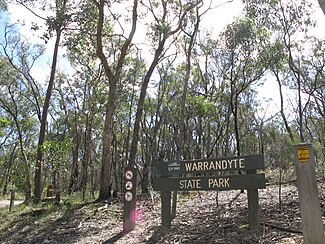Warrandyte State Park
| Warrandyte State Park | |
|---|---|

The Warrandyte State Park at the tunnel street entrance
|
|
| Type | State Park |
| Location | Melbourne, Australia |
| Area | 586 hectares |
| Opened | 1975 |
| Operated by | Parks Victoria |
| Status | Open (8:30am-9pm) |
| Paths | Unsealed bush paths and hiking trails |
| Terrain | Heavily forested hills, valleys, gullies, riverbanks and flats |
| Water | Yarra River, Andersons Creek, Jumping Creek, Various other creeks and gullies |
| Vegetation | Australian Native |
| Connecting transport | Car (limited parking), Bus (indirect service) |
| Landmarks | Yarra River, Fourth Hill, Warrandyte Gorge, Gold mine ruins |
| Facilities | Toilets, Seating, Interpretive Signs, Canoe Ramp |
Warrandyte State Park is a state park, located in Warrandyte, east of Melbourne, Victoria on the banks of the Yarra River and surroundings. The park comprises 586 hectares of remnant bushland in various locations throughout Warrandyte and Wonga Park around Pound Bend, Fourth Hill, Black Flat, Yarra Brae and various other locations in the area. It hosts many significant geographical, environmental, archaeological and historical sites, such as the site of the first gold discovery in Victoria in 1851 and preserves the sites of former gold mines and tunnels. It is a popular destination for school and community groups and is frequented by local bush walkers and hikers.
Land now occupied by the park was initially occupied by Indigenous Australians of the Wurundjeri nation. After European settlement, gold was discovered in Warrandyte, and the area was mined for a number of years. Frequent clearing had at one stage removed all the vegetation in the area, and bushfires have erased much of the recent human architectural history of the area. However, they have ensured the health of the bushland and reduced the impact of human settlements, enabling the vegetation to recover throughout the 20th century. The major threats to the park's ecology are introduced species of flora and fauna such as foxes, rabbits, dogs and cats. Being located close to suburban settlements, backburning is regularly undertaken within the park to minimise risk of bushfires.
Land now occupied by the park was initially occupied by Indigenous Australians of the Wurundjeri nation. After European settlement in Melbourne, settlers were slow to spread out into the hills east of Melbourne into the Warrandyte area, but with the discovery of gold at Andersons Creek in July 1851, the first gold licences in Victoria were issued. At the turn of the century, the settlement at Warrandyte, employed about 250 miners. Much of the area was mined heavily throughout the late 19th and early 20th centuries, this was done in sections leaving large slots or "stopes" underground where the reef had been. Many of these mine shafts, structures and stopes remain as ruins throughout the park.
...
Wikipedia

